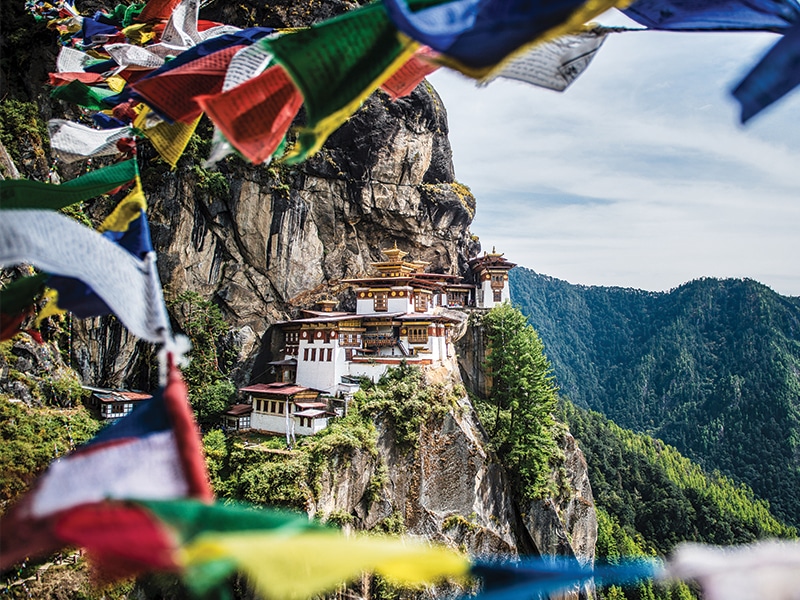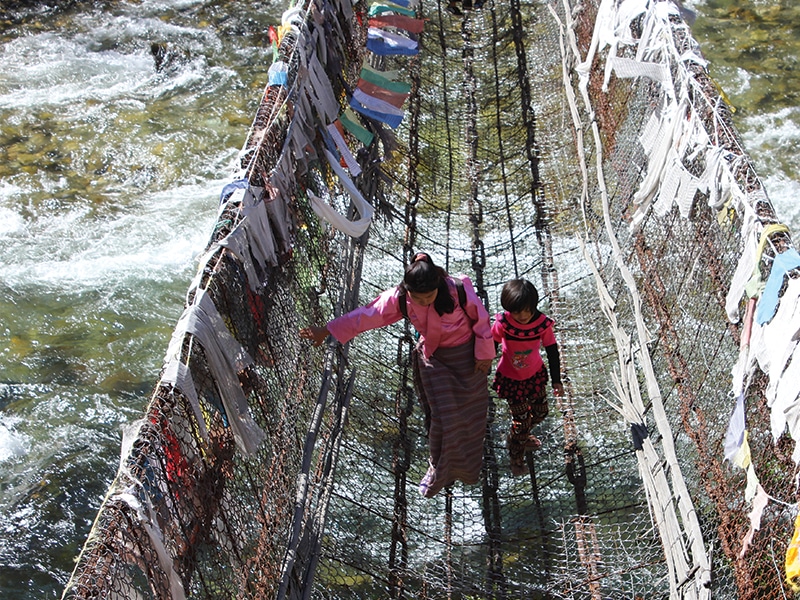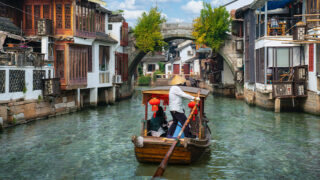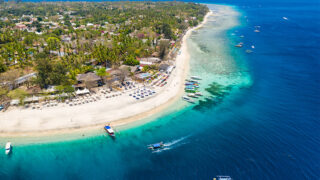Anyone who spots an image of the Tiger’s Nest Monastery clinging to a cliffside in Bhutan quickly adds this country to their travel bucket list. And it’s a must-visit for many more reasons: beautiful landscapes that are deeply respected by the population; atmospheric old forts (dzongs); a philosophy based on “Gross National Happiness” rather than Gross Domestic Product; plus interesting food, arts and crafts, and more. If you’re thinking about a trip, read our rundown of all the essential information to help you plan!
The basics
Population: 790,000
Capital: Thimphu (the international airport is at Paro, which is an hour or so away by car)
Religion: Approximately three quarters of the population is Buddhist, and the other quarter Hindu
Emergency number: 113 (police), 112 (ambulance)

Fact file
- There are no traffic lights in Thimphu, the capital.
- Bhutanese will refuse a gift three times before accepting it.
- Archery is the national sport.
- Bhutan banned plastic bags way back in 1999.
- National dress is compulsory for formal occasions for Bhutanese citizens.
Key dates
Bhutan uses its own calendar, a variation on a Tibetan calendar, so it’s important to look into holiday and festival dates before you travel.
Two particularly big days bookend each year. These are 2 January, or Nyinlog, which is a winter solstice festival and considered the most auspicious day on the calendar, and also 17 December, which is National Day.
Hot spots and itineraries
Popular destinations include Thimphu, Paro, Punakha, the Phobjika Valley, Gangtey and Bumthang.
Some itinerary ideas
- The Essentials: Paro – Thimphu – Punakha – Gangtey
- The Challenge: the Snowman Trek is a legendary four-week walk in the Himalayas, with some campsites above 5,000 metres.
Staying safe and healthy
Travellers’ complaints in Bhutan are generally the same as those in other countries in the region, ranging from diarrhoea to more exotic illnesses. Look into travel vaccinations before you go, and take the regular precautions when eating (be wary of buffets that may have been sitting around for some time, for example). If you’re trekking the high altitudes, be sure to acclimatise, and familiarise yourself with the symptoms of AMS (acute mountain sickness).
Cultural things
While you’re there, please don’t…
- Act disrespectfully in a dzong or other religious site. This means you should avoid tight or revealing clothing, take off your headwear, and refrain from swearing or making negative comments about religious leaders.
- Walk the wrong direction around temples and mani walls; follow the locals, who you’ll soon notice are all walking clockwise.
Before you go, read …
- The Circle of Karma by Kunzang Choden – the debut novel (2005) of one of Bhutan’s foremost writers.
- Beyond the Sky and the Earth: A Journey into Bhutan by Jamie Zeppa – the memoir of a Canadian woman’s two-year stint in the country.
Before you go, watch …
- Travellers and Magicians – the first feature film shot entirely in the Kingdom of Bhutan, directed by Tibetan lama Khyentse Norbu. It received some international attention, including a couple of awards.
They said it
“Nothing could be more striking than the pristine, haunting beauty of the landscape of Bhutan, or the atmosphere of peace and sacredness, which pervades the land from end to end.” – Sogyal Rinpoche, Buddhist spiritual master
“If I had to name the biggest difference between Bhutan and the rest of the world, I could do it in one word: civility.” – Linda Leaming, author

Important questions
Do I need a visa?
All tourists (excluding Indian, Bangladeshi and Maldivian passport holders) require a visa when visiting Bhutan. You can apply for an e-visa online here, or a licensed Bhutanese tour operator or one of their international partners can arrange a visa on your behalf when you’re booking your trip.
Be aware that Bhutan imposes a daily fee – known as the Sustainable Development Fee (or “tourist tax”) – on travellers. Until recently, this was $US100 a day, but in 2023 the figure was reduced by 50 percent.
What time is it in Bhutan?
Bhutan time is 6 hours ahead of GMT, 2 hours behind Singapore, and 4 hours behind Sydney.
What’s the money situation?
Bhutanese currency is the ngultrum (Nu), which has no coins but only notes. Indian rupees, which are on par with the ngultrum, are also accepted, except in Rs500 and Rs1000 currency notes. They’re also occasionally given as change. ATMs accepting Visa or MasterCard are found in main towns. Major hotels and tourist shops also accept credit cards but travellers’ cheques and cash are the easiest here.
When’s the best time to visit?
Bhutan can be visited year-round but the best months are between March and May and September and November. Winter runs from mid-November to mid-March; at this time of year, the climate is dry and sunny for the most part, with perfect blue sky, and temperatures peaking at around 15 degrees Celsius in the daytime and falling below zero at night. The monsoon usually arrives in mid-June, with light rain falling mainly in the afternoons and evenings.
What’s the lingo?
Dzongkha is Bhutan’s national language. English is commonly spoken in main towns. Here are some phrases to get you started:
- Hello: Kuzu zangpo la
- What is your name? Na gi chen ga chi mo?
- My name is __: Nge gi ming __ een
- How much? Gademchi mo?
- Thank you: Kadinchey la
- Yes: Ing
- See you again: Log jay gay
Last but not least
Is there anything I should know about meeting the locals?
A formal greeting is to bow with hands open and outstretched and the palms up.
What’s a must-try dish?
Ema datshi, a chilli-and-cheese stew, and jasha maroo, spicy chicken.
What should I buy as a souvenir?
Postage stamps. Bhutan is a philatelist’s dream; visit the philately counter at the National Post Office at Chang Lam to buy some colourful local stamps; for a unique a unique souvenir, buy a personalised stamp with your picture on it. Other great gifts include handicrafts made from bamboo or cane, and jewellery and beads.
For more holiday ideas, head to our Travel section!





